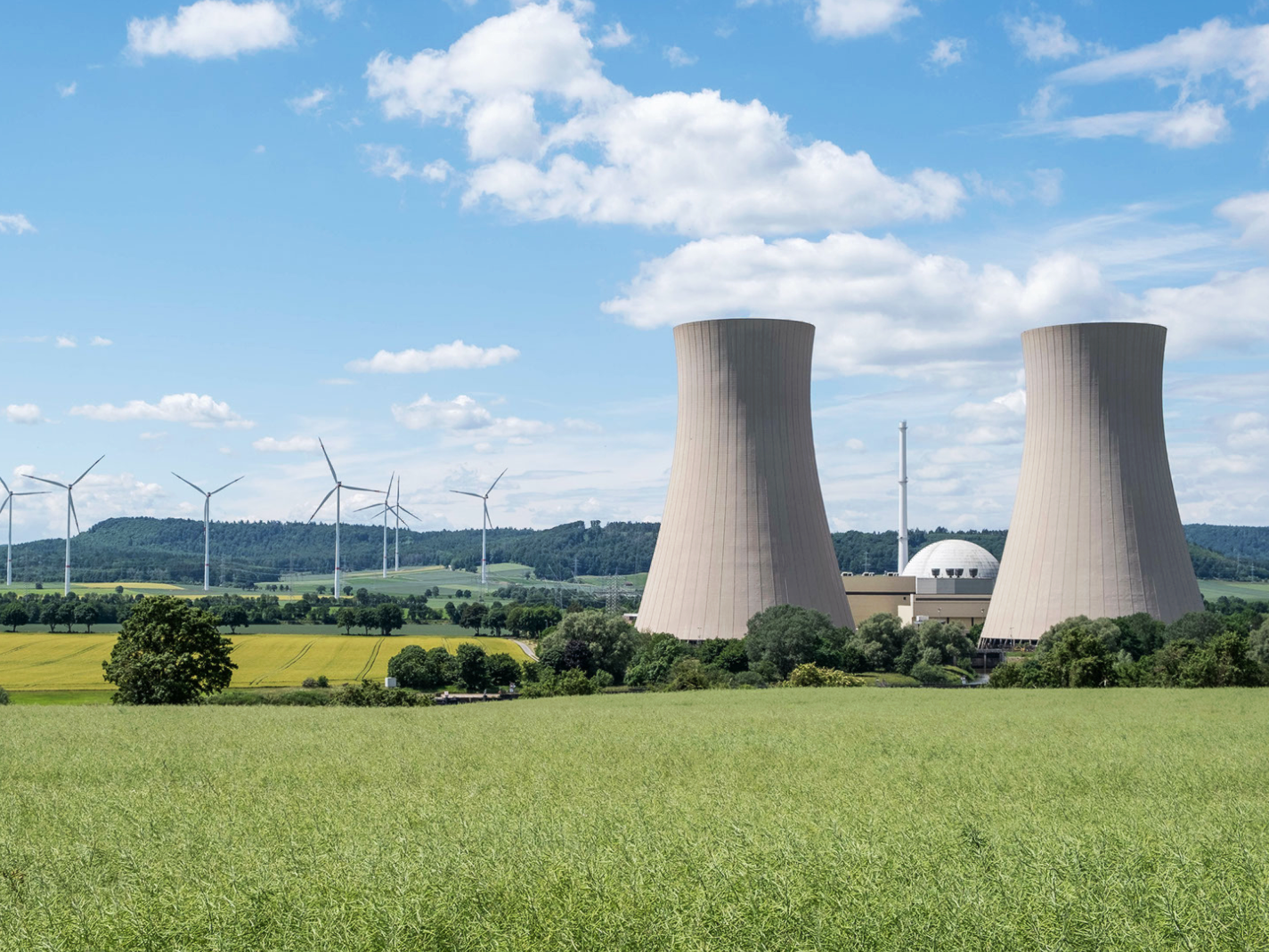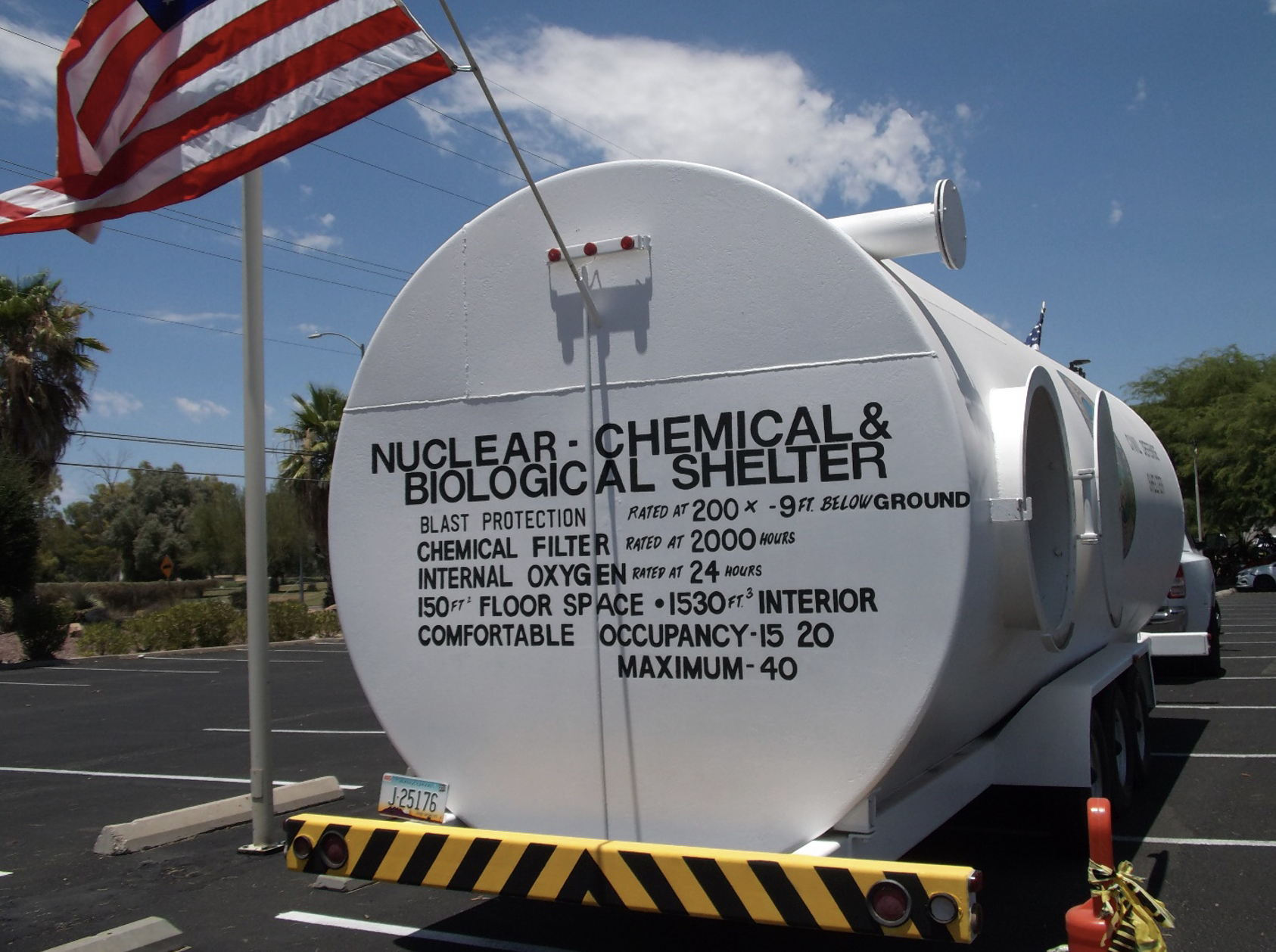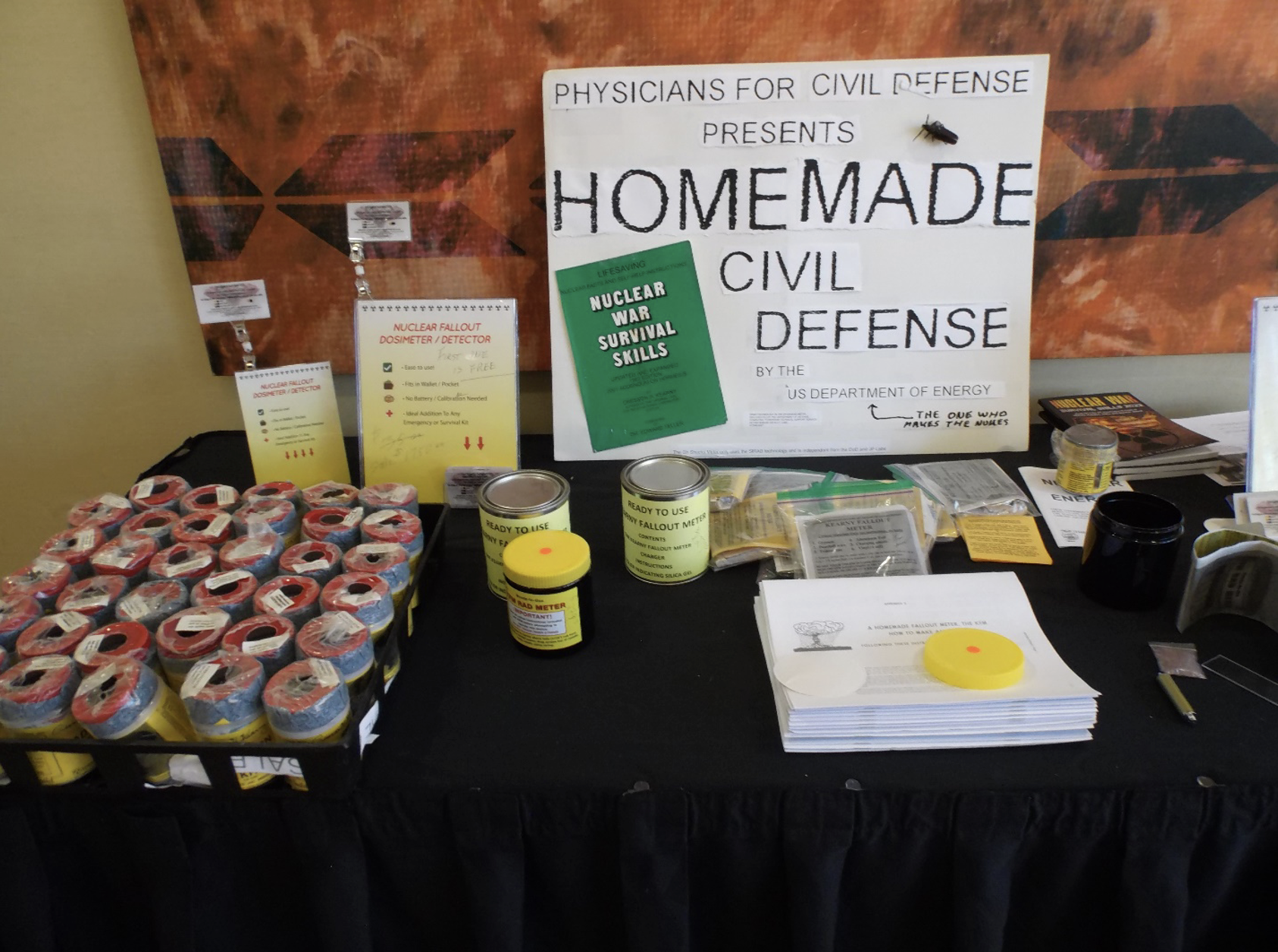
In July, I attended the 41st Annual Meeting of Doctors for Disaster Preparedness (DDP) in Tucson, Arizona. The meeting opened with the national anthem played beautifully on the trumpet and the violin by the teenage sons (Benjamin and Franklin!) of Willie Soon, the first speaker.
DDP was founded in the early 1980s as a “group of physicians, scientists, and interested citizens” who support “honest science” and the “prudent management of resources for future generations.” It also emphasizes “homeland defense” and preparedness for nuclear disaster, including the use of nuclear weapons. Its pamphlet notes that “at least 10,000 nuclear weapons are currently aimed at the United States.” To highlight the need for preparedness, DDP hauled in a nuclear shelter to the parking lot of the meeting venue. The first lunchtime speaker, Stephen Jones, summarized what to do in case of a nuclear attack and provided radiation detection cards, which can be carried in a wallet.


The DDP conference also provided a platform for an eclectic variety of speakers who have been canceled for viewpoints that differ from mainstream academic and government positions. Linda Sweeney, founder of Alumni and Donors Unite, spoke on the encroachment of DEI in medical schools, insisting that universities focus on critical thinking rather than critical race theory. James Enstrom, emeritus professor at the University of California, Los Angeles, discussed political corruption in scientific organizations, such as the American Cancer Society. You may find a list of the major talks here. These and other talks will be the focus of this article.
I do want to mention at the outset the uneven nature of the talks. For example, a lunchtime talk by Donald W. Miller, a retired cardiothoracic surgeon, was a Neo-Confederate explanation of the American Civil War, which was not, according to Miller, about slavery. His message was that the US would have been better off had the Southern states been allowed to secede from the Union. The Confederacy would have given up slavery regardless. He added that the Civil War was not that long ago—really just two or three generations back.
[Related: “Minding the Sciences — DEI Takes the NIH”]
Miller’s talk, which seemed out of place at the conference, was not well received. Robert Zubrin, a nuclear engineer who spoke at the previous evening’s banquet, contested Miller’s views and noted that the world is still half enslaved and half free. Zubrin emphatically argued that technical progress, which was then being pushed by Republicans in the Northern states, was and still is the way to fight for freedom. His comments received strong applause.
Other talks were more sales pitches than scientific presentations. John McClain, for example, spoke on ozone as a sanitizer, which may have been more interesting if the talk hadn’t been an advertisement for McClain’s company. Similarly, an unconvincing lecture on red light therapy, which claimed that it helps heal everything from the Pope’s shattered knee to an Olympic athlete’s long COVID, was reminiscent of an old-time snake oil sales pitch. I don’t doubt that warmth can help heal us—after all, ice numbs and warmth soothes—but the extent to which red light therapy contributes is doubtful.
These misfires aside, the conference had many highlights and some thought-provoking speakers. The main themes can be summed up as: concerns about the climate; technology to improve the environment; and preventing government control over people’s lives. Regarding the climate and the environment, speakers emphasized that the changes we see are not disastrous. Rather, they would be better addressed if the government and others in power supported technological advances rather than fanciful (and perhaps malicious) ideas about moving us back into a pre-industrial existence. Some of the speakers saw a conspiracy to actively preclude technological solutions, so as to create dependence by inhibiting individuals from responding to challenges as they see fit. Others were less convinced of a conspiracy and just accepted that bad ideas can flourish or that bad players (e.g., China or Russia) can take advantage of liberal concerns.
Speaking of China, many at the meeting were seriously concerned about the US lagging behind communist countries. Although my own thought process tends to shy away from conspiracy theories and to blame foolishness and laziness instead, it is understandable why some speakers were less generous in their assessments. For instance, Steven Hatfill, a physician and virologist who was once a key suspect in the 2001 anthrax attacks, spoke on the dubious claims of the COVID-19 pandemic response, which are now looking like flat-out lies, including: the virus was a natural outbreak, surgical masks are safe and effective, vaccines prevent transmissions, and mRNA vaccines are superior to natural immunity. His solution for the next pandemic was to return decision-making power to non-governmental entities, which would avoid vaccine mandates, the illegitimate use of emergency powers, and the obstruction of doctors obtaining and prescribing off-label medications. Other speakers, such as Marc Morano (whose latest book is called The Great Reset), discussed COVID lockdowns as a test run for potential climate lockdowns, as well as other government abuses, such as Canadian truckers’ bank accounts being frozen by Justin Trudeau for their protests against vaccine mandates.
Willie Soon is an astrophysicist at the Center for Astrophysics | Harvard & Smithsonian. Soon gave the opening talk on “Global Societal Crises of the 17th Century: Perspectives from Research on Sun-Earth Relations.” He spoke about the widely ignored lack of evidence that climate is controlled by changes in atmospheric CO2. He summarized historic variations in climate, such as the Little Ice Age, which was documented in Europe from about 1645 to 1715 but which ran from about 1300 to 1850—the coldest period since the Ice Age ended. This cooling period was most likely controlled by sun activity variation (known as the Maunder Minimum) rather than CO2. Soon also discussed his search for the oldest historic sunspot images, which are indicators of solar activity, as well as the yet-unexplained seasonal effects of volcanic eruptions and earthquakes. He didn’t make any predictions about climate, but instead focused on natural variation rather than man-made changes. For this politically incorrect view—i.e., that the sun, not atmospheric CO2, mainly controls the Earth’s temperature—he has faced cancellation attacks, including lawsuits.
Interestingly, much of the information that Soon presented has been widely accepted by anthropologists and historians. The Little Ice Age, for instance, is covered in many mainstream social science and history websites. It is, rather, his contention that prehistoric and historic variants can tell us more about the present or future climate that makes him problematic for environmental activists and researchers. Soon attributes climate change to natural occurrences and not man; thus, regulations to prevent climate change are unnecessary and can even be harmful.
Terry Gannon, a research fellow at the Independent Institute, gave a great follow-up talk on climate regulations. Gannon, who holds a PhD in engineering and physics, suggested that climate policies designed to bring the US to “net zero” (i.e., more CO2 is removed than is produced) will put us at a great disadvantage, especially when rivals like China are free from such restraints. He argued that net zero will be a steep uphill climb. For example, even though Arizona has the best peak solar energy in the nation, only 10% of the state’s electricity comes from solar and wind power—and even that is inherently unreliable, leading to increased blackouts and government limits on A/C use (which, as I shivered in the highly air-conditioned banquet room, made me think that might not be such a bad idea!).
[Related: “Minding the Sciences — What Is Science?”]
Gannon also discussed the effects of solar and wind energy on the natural world. Birds, for instance, are killed in vast numbers by wind turbines. Paul Driessen, a senior policy advisor with the Committee for a Constructive Tomorrow, noted the number of whale deaths due to wind turbines in oceans. Several speakers mentioned that the vast amounts of lithium and other rare-earth minerals needed to manufacture electric vehicle batteries raise humanitarian concerns about China, which dominates the market for these batteries, and which uses slave and child labor both at home and in the African mines it oversees.
Gannon’s solution is to focus on nuclear energy, a point echoed by several other speakers, notably Robert Zubrin, whose most recent book is The Case for Nukes: How We Can Beat Global Warming and Create a Free, Open, and Magnificent Future. Zubrin supports technological progress and notes that although the climate may be warming slightly, this isn’t truly a problem. He doesn’t think that climate change is a disaster waiting to happen. Rather, he argues that the real problem may be that of CO2 emissions rising to unsustainable levels in the future. Zubrin, one of the conference’s most outspoken attendees and—in my opinion—the best of the speakers, made a strong case for nuclear energy as the best way to manage both atmospheric CO2 and humanitarian concerns. Zubrin spoke of the hopelessness of solving energy needs and environmental problems with what he called “pre-fossil fuels,” i.e., renewable wind and solar energy. Departing from doomsayers such as Paul Ehrlich, who have advocated population control, Zubrin recognizes that technology comes from people and that innovations are cumulative. In this, Zubrin does not forget freedom and quality of life, as the Ehrlichs of the world are prone to do. It is not the rise in CO2 that should be our focus, but the energy needs of a growing population. Increased productivity in farms, increased nutritional value of genetically modified foods, and increased prosperity all require energy. It is possible to bring all people to the US standard of living, and to do so, technology and nuclear energy are the best paths to follow.
The fear of nuclear energy is the principal obstacle to this bright future, and Zubrin puts it to rest. The worst nuclear energy disasters, as bad as they were, should not impede the development of nuclear energy. In the case of Three Mile Island, for example, the reactor melted down, but the radiation didn’t make it outside of the shell, and no one was hurt. In the case of Fukushima, no one outside of the plant was hurt. Chernobyl, on the other hand, was a dual-purpose nuclear plant (energy and weapons) and used graphite containment (rather than the usual water coolant containment), which created a different type of disaster: a runaway chain reaction, fires, and deaths. Yet, the population was harmed more by the Soviets’ unwillingness to take action and admit fault; thus, although potassium iodide pellets were available and could have helped prevent radiation poisoning, the Soviet government did not distribute them.
If nuclear energy is safe, efficient, and clean, then why don’t we have more of it? Zubrin noted that technological advances have stalled ever since competition between the US, the Soviet Union, and China was curtailed by ITER, the world’s largest collaborative fusion energy project. ITER members, including China, the European Union, India, Japan, Korea, Russia, and the United States, are supposed to collaborate and build a fusion reactor. However, instead of spurring nuclear innovation, it took the members twenty years to decide where the reactor should be built! The bigger problem seems to be government hyper-regulation, which stalls progress for decades and makes building a nuclear plant exceedingly costly. Zubrin concluded by noting that nuclear power could restore the world’s fisheries by pumping up bottom water and making the ocean bloom again. Yet, the anti-progress and anti-people agendas typical of environmental activists block these types of solutions. In 2012, for instance, when Russ George helped the indigenous Haida of British Columbia restore the salmon run by adding iron to key waters, he barely escaped prosecution from Environment Canada, even though his technique worked.
James Enstrom, meanwhile, criticized the American Cancer Society and the faulty research it relies on to link fine particulate matter to cancer deaths. Although inhaling particulate matter can cause cancer, there is a threshold that is safe, and the American Cancer Society has placed the acceptable limit far lower than the data support, according to Enstrom. Like the quixotic quest for net-zero emissions, Enstrom argued that pursuing nearly perfect air quality is futile, driven by faulty science, and propped up more by political convenience than by sound data. Illogical restrictions on the US to further improve air quality will lead to an inability to compete with other nations, such as China.
Many speakers emphasized environmentalism’s anti-people agenda and its desire to turn back the clock to a simpler, greener time. To achieve this ideal, our mobility must be limited (e.g., Morano’s discussion of climate lockdowns and France’s ban on short-haul flights), dams must be destroyed to allow salmon to migrate (e.g., Bacigalupi’s discussion of dam destruction in California), the use of genetically modified foods must be limited, and organic farming must be imposed (e.g., Driessen’s discussion of the organic farming movement in Sri Lanka that led to widespread starvation). They also pointed out that these restrictions—whether they are restrictions on mobility, financial incentives to control behavior (e.g., the desire to keep fossil fuel prices high to force people to cut down), or dietary restrictions (e.g., eating bugs rather than beef, as Bacigalupi pointed out, even bringing some bugs with her for attendees to try)—will not affect the elite. France’s short-haul flight ban, for instance, does not include private jets. This “stick”—rather than “carrot”—method to take control of the climate is anti-progress and anti-freedom. Most of the attendees and speakers at DDP, on the other hand, were hopeful that progress and technology could solve the world’s problems—preventing disasters and improving our lives.
Editor’s Note: This piece is part of a new Minding the Campus article series called Minding the Sciences, wherein we are renewing our focus on the sciences given the many threats it faces in modern academia. Click here to learn more.
Image: Adobe Stock

I wouldn’t be as nonchalant in dismissing Three Mile Island, Fukushima, Chernobyl — and possibly Zaporizhzhia in the Ukraine. There are already disturbing reports coming out of Zaporizhzhia, with both the Russians and Ukrainians saying that the other side intends to sabotage it to create a far worse humanitarian disaster than Chernobyl.
What needs to be said about Three Mile Island, Fukushima, and Chernobyl is that they were designs using old technology which would never be permitted today, the first two being 1950’s technology and Chernobyl essentially being out of the Manhattan Project. In spite of that, though, the accidents occurred as a result of human stupidity</b..
The biggest problem at Three Mile Island is that they only had ONE phone line into the control room. This was 1979 — before cell phones — and the problem was that the various experts simply couldn’t get through to them. Sure, it’s cheaper to only have one line instead of the extra three or nine that you are “never going to use” but someone should have insisted they have the extra lines anyway. (And today, people would simply use their personal cell phones…)
Fukushima was even more stupid. Japan has a long (well documented) history of earthquakes and resulting tsunamis. Instead of building on the higher side of the island, where land was more expensive, they built on the lower and cheaper land. By the 1990s, people were warning about the vulnerability of this plant to a tsunami — and a sister plant seven miles away was fixed (and didn’t blow up).
When the earthquake hit, the plant shut down, as it was supposed to, and then relied on grid power to run the necessary cooling pumps. The tsunami took out both the power lines connecting them to the grid and the emergency Diesel generators running in the basements, but the plant *still* would have been OK because the three new Diesel generators, added in the 1990s, had been located higher on the hillside and were fully functional. Except that the switching equipment to connect them was underwater in the flooded basements…
Human stupidity and not spending a couple thousand dollars in wiring is what caused Fukushima…
And as to Chernobyl, that wasn’t the first plant of that design to blow up — the Mayak plant had blown up 29 years earlier, except that the Soviets managed to keep that one pretty much quiet. But above and beyond that, it was boys playing with toys that caused Chernobyl, they removed more control rods than the limits permitted. Arguably it was a bit more complicated than this, but then again, it really wasn’t.
My point is that we should not dismiss the concerns about past accidents at nuclear power plants — particularly if, heaven forbid, something goes bad at Zaporizhzhia. Instead we need to point out just how unsafe the automobiles of the 1950s actually were, without seat belts, air bags or even safety glass, brakes that would completely fail without warning, wouldn’t work after driving through a puddle, and had to be manually adjusted, etc.
Modern fission plants are way safer than those designed in the 1950s, and breeder reactor technology eliminates most of the waste problem by enabling the reactor to re-use it. There are even plants that somehow use gravity to move coolant water, thus eliminating the possibility of another Fukushima.